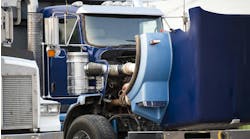Although the biggest news in trucking right now is the changeover to '07-emissions-compliant engines, we're at least three or four years away from knowing what impact they will have on used truck prices. According to Terry Williams, editor of the Truck Blue Book, the data he's seen on used trucks spec'd with '02 engines indicate that low-emissions engines may not have much bearing on the price of trucks spec'd with '07 engines when they hit the used truck market.
“To date, the '02 engines [in general] have been a non-issue in terms of pricing impact on used trucks,” he says. “Though there were problems with them, they were fixed under the manufacturers' warranties on the front end, so they haven't affected overall valuations very much.”
What has affected used truck pricing, however, is the rate of specific '02 engine failures. “Failure rates of certain makes and models of '02 engines definitely impact used truck pricing,” Williams says.
“Going into 2007, however, we have a much higher confidence level in engine performance — they were tested longer, for starters — so we don't expect that same issue to recur.”
The real '07 issue for used truck buyers down the road will be the diesel particulate filters (DPF) that are required as part of the '07 emissions solution. “The first concern with DPFs is theft: they contain platinum and can be worth $3,000 and up,” says Williams. “In a market where theft of old tires is a problem, this adds a greater level of worry.”
The second concern is how you figure out where a DPF is in its life cycle. “These filters last only so long, so dealers and owners alike need to find a way to determine how close a DPF is to the end of its usable life when they take a used truck in on trade or buy one for their operation.”
Of more immediate concern, Williams believes, is adjusting to the rising number of tractors with rear axles equipped with wide-base tires. “We've had nothing but good reviews of wide-base tire performance on new vehicles; the fleets using them are picking up fuel savings,” he says. “However, the acceptance of wide base tires hasn't translated to the used market yet. It costs money to change the rear axles over to accept dual wheel assemblies again, and used truck dealers don't get any core credits from turning in wide-base wheel assemblies.”
Many used truck dealers would like to get upwards of $5,000 in deductions for taking in used trucks equipped with wide-base tires, says Williams, but that's just not in the cards. “Wide base is becoming a preferred rear-axle setup for many fleets so the used market is going to forced to come to grips with this over the next three years,” he believes.
Two trends that Williams expects to continue are the growing worth of certain auxiliary power units (APUs) in terms of boosting resale value, and the sustained preference of “cowboy trucks” over sleeker aerodynamic designs among used truck buyers.
“You can still get $5,000 to $6,000 more for a ‘cowboy’ style truck — squared off edges with lots of chrome — compared to an aerodynamic model,” he says. “As fleets still predominantly spec aerodynamic models, those cowboy-styled models are going to remain in short supply, keeping values up.”
APUs are also proving to be a worthwhile investment in terms of resale value. That is, as long as they have brand recognition, are powered by diesel generators rather than the truck's batteries, and don't have a lot of hours on them when the truck is traded in or sold.
“APUs have boosted used truck residual values since 2001 and we see that continuing, depending on the quality of the unit and how many hours it has on it,” Williams says. “If it's powered by a diesel generator and is a recognized brand name like Thermo King, it'll definitely add value. But there will still be a deduction on that APU based on its total overall hours of operation.”


